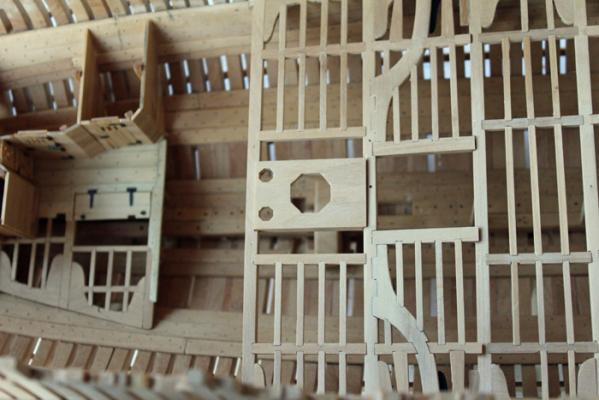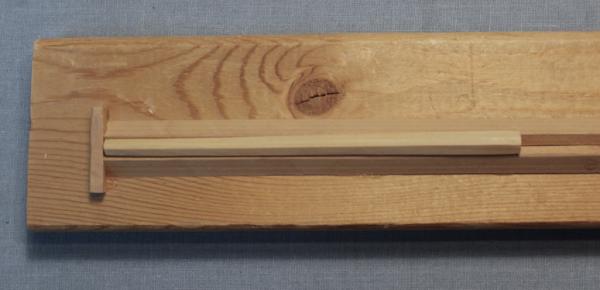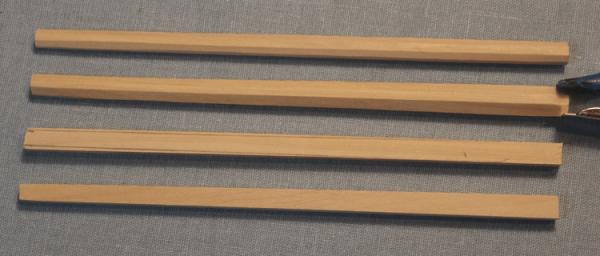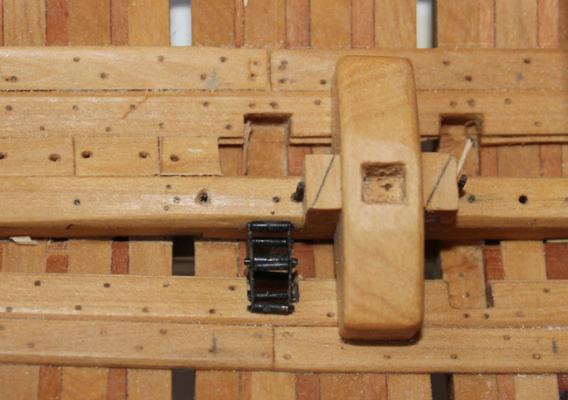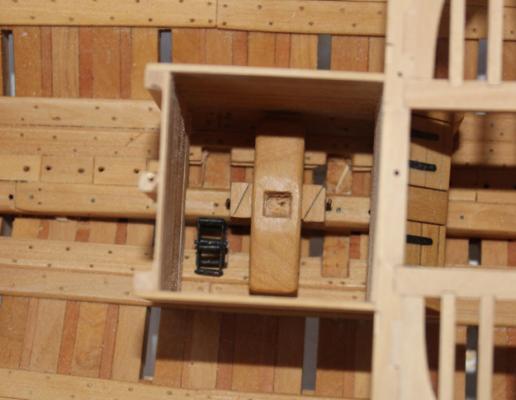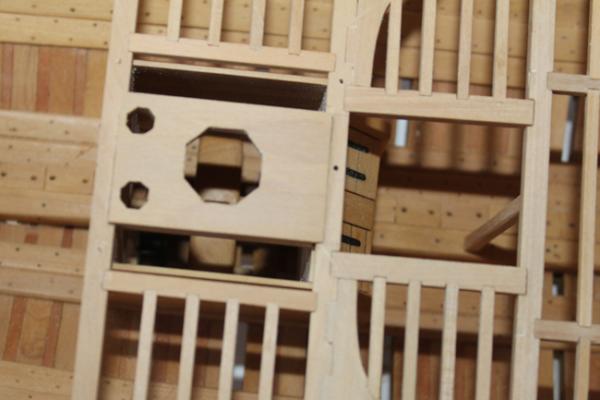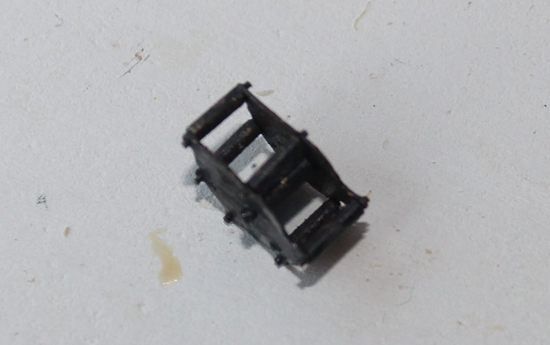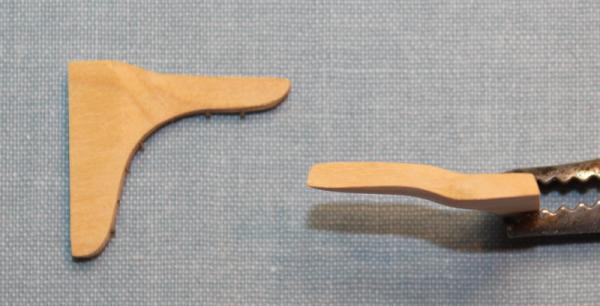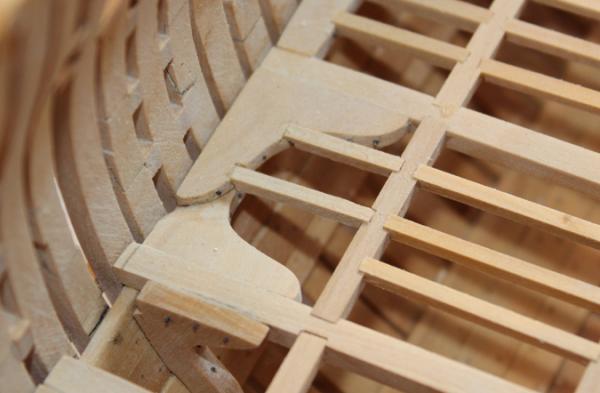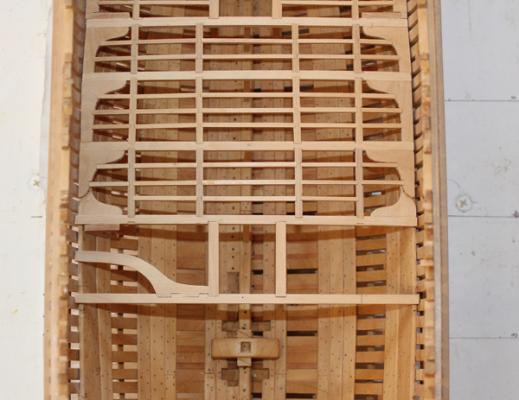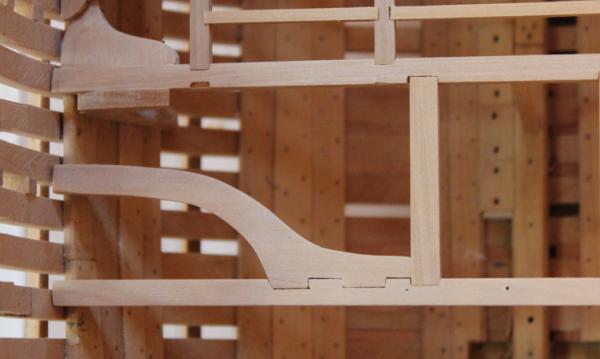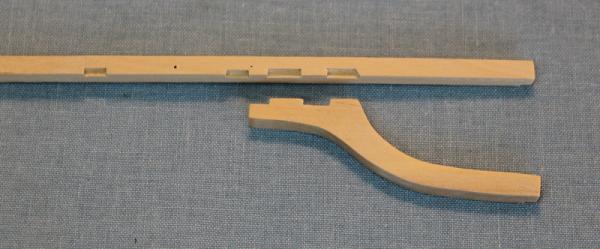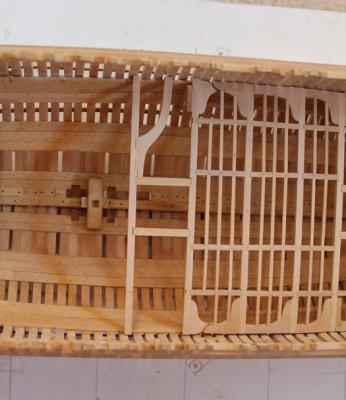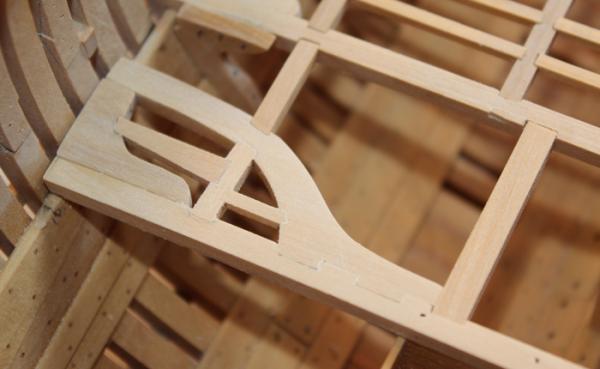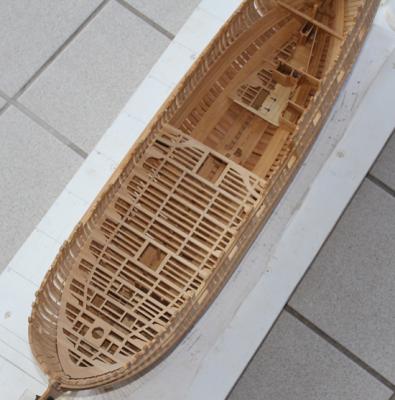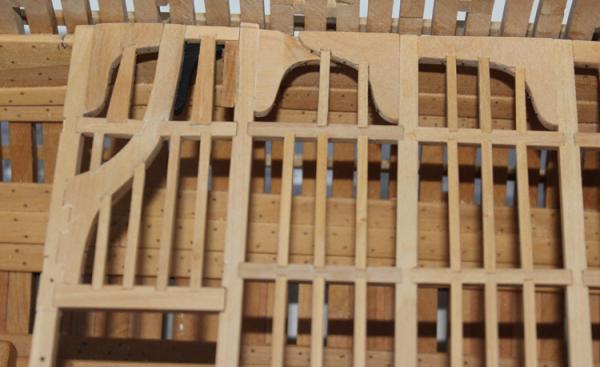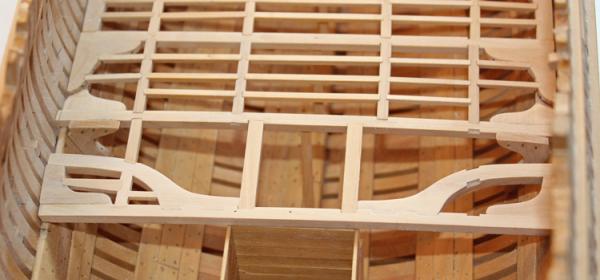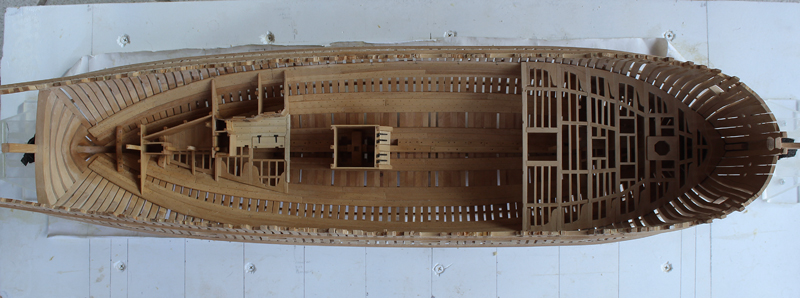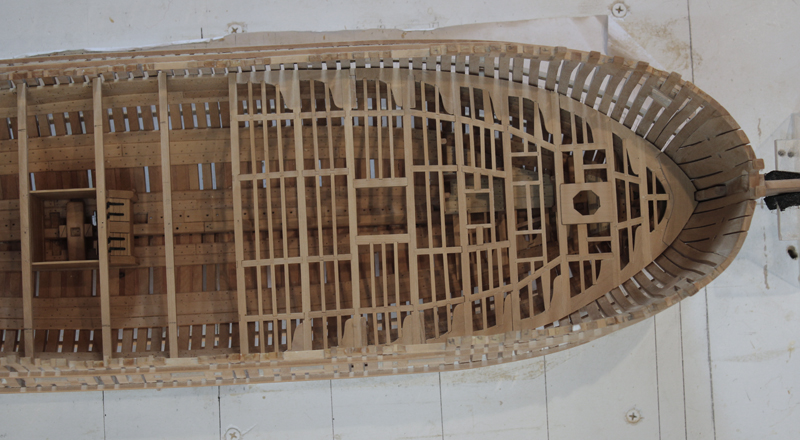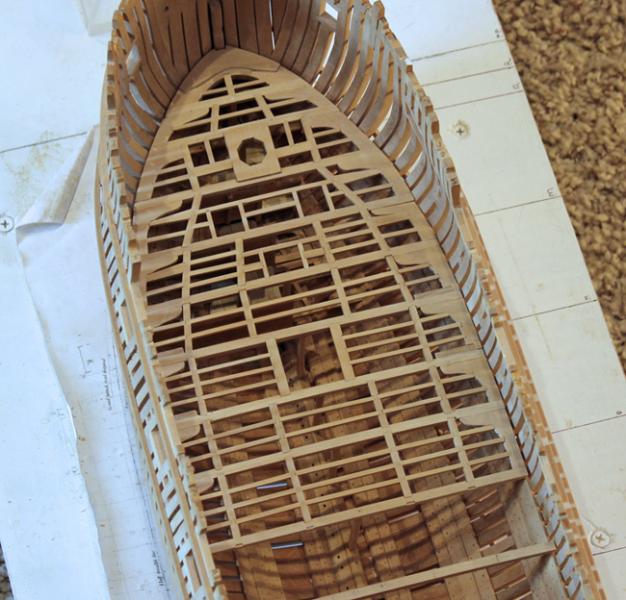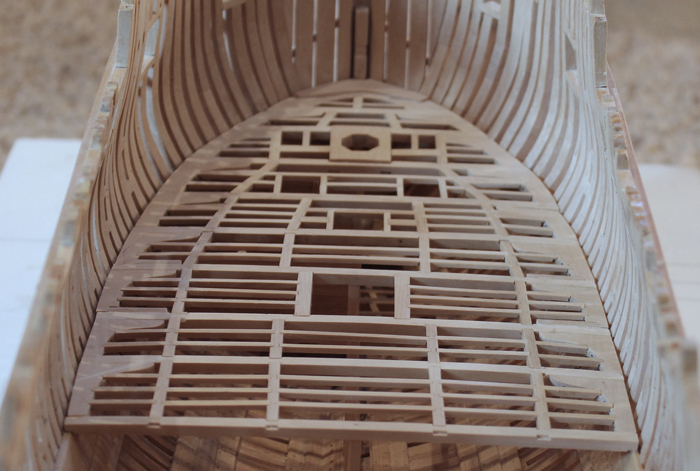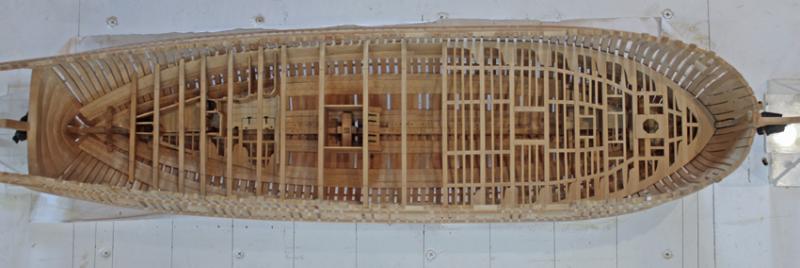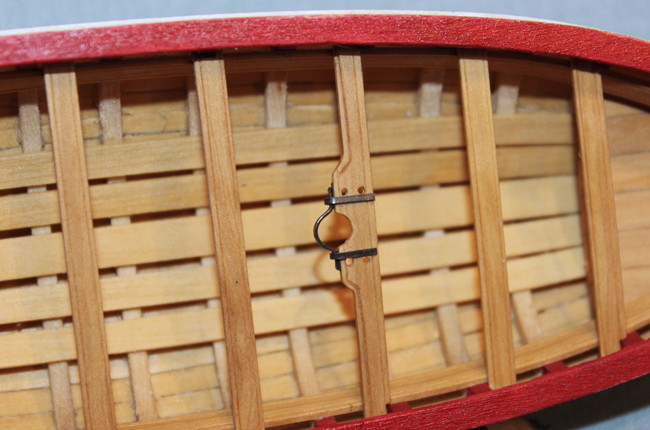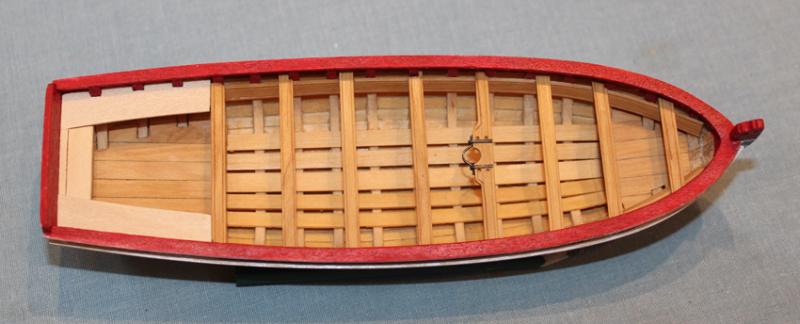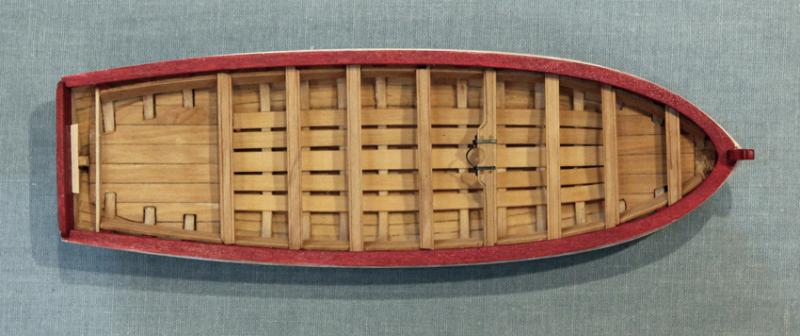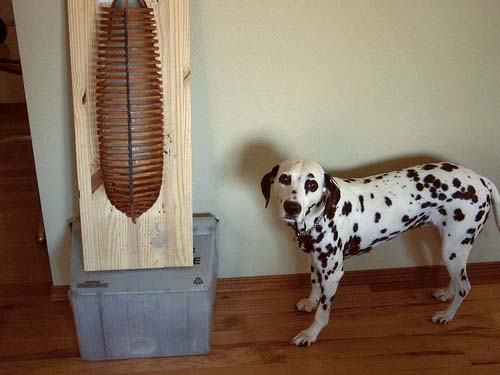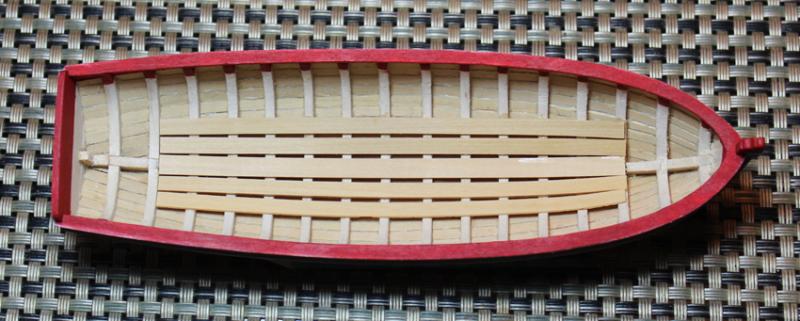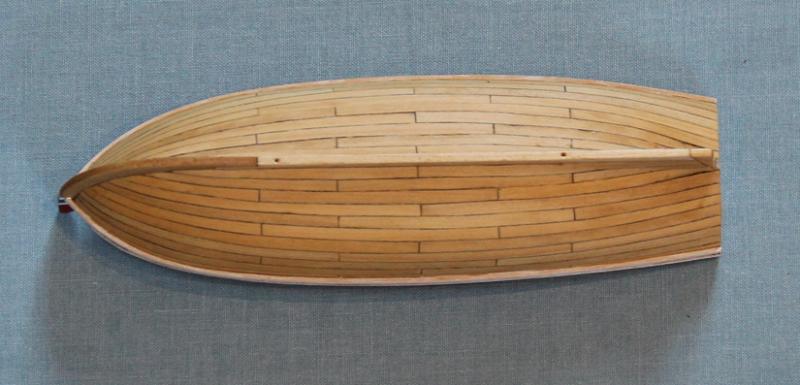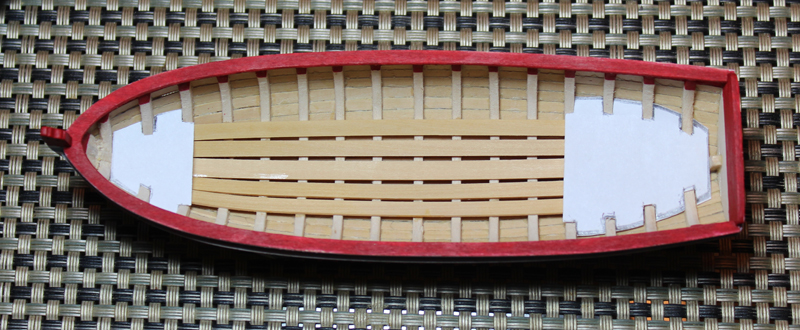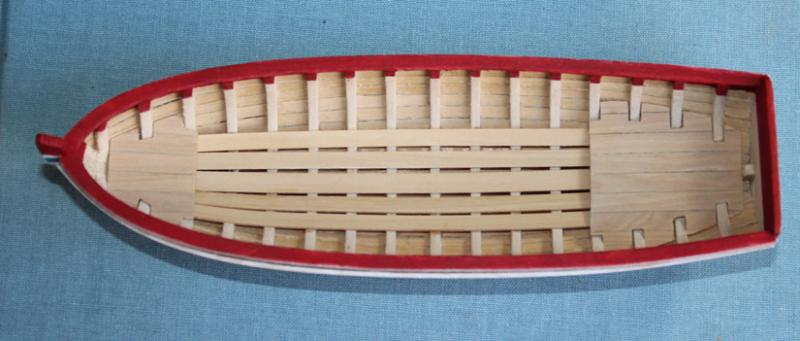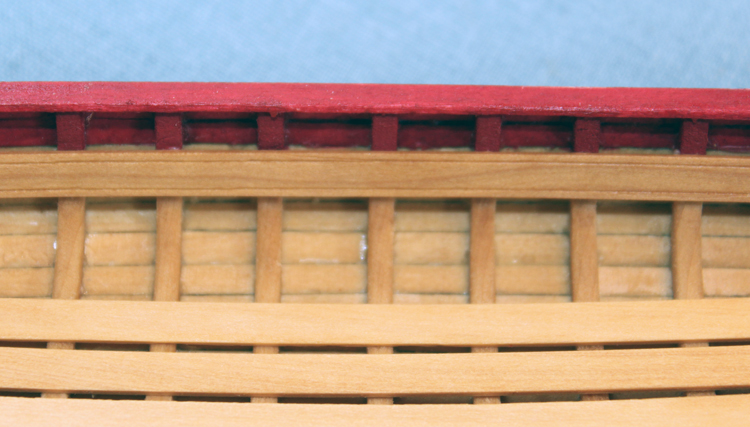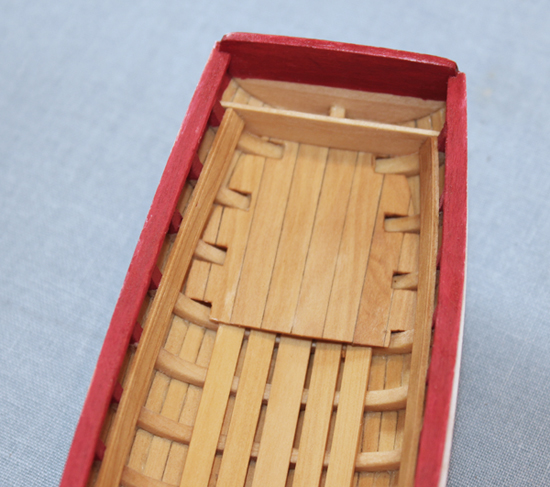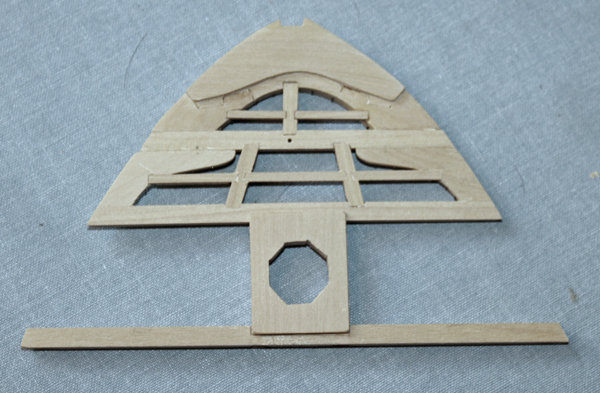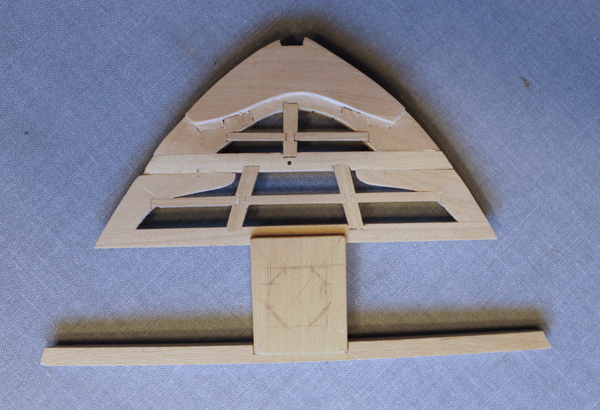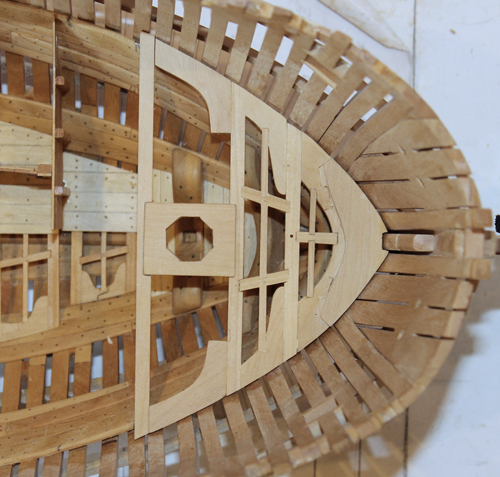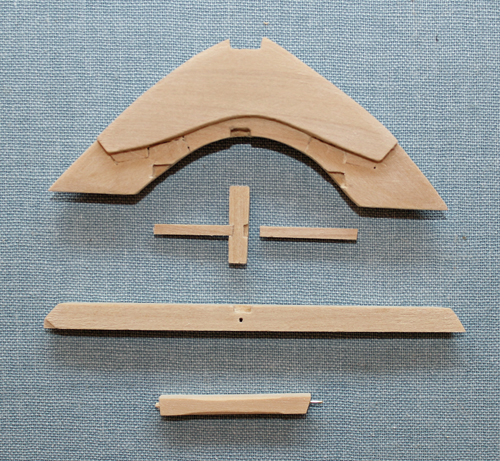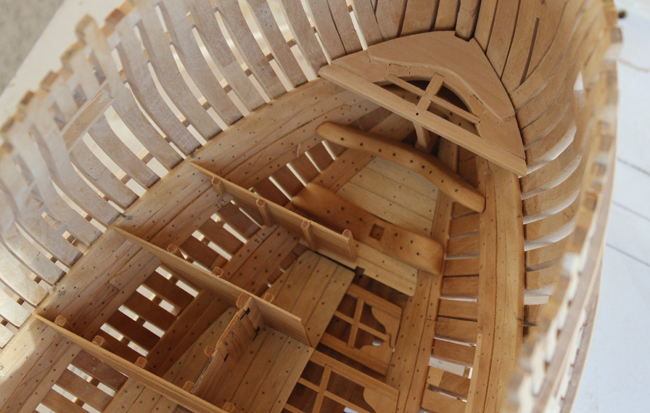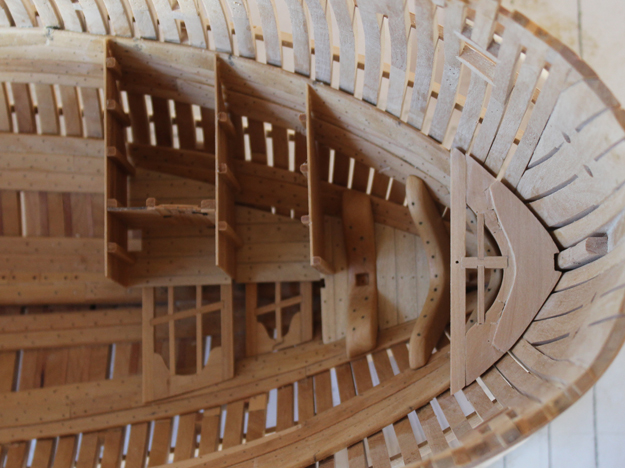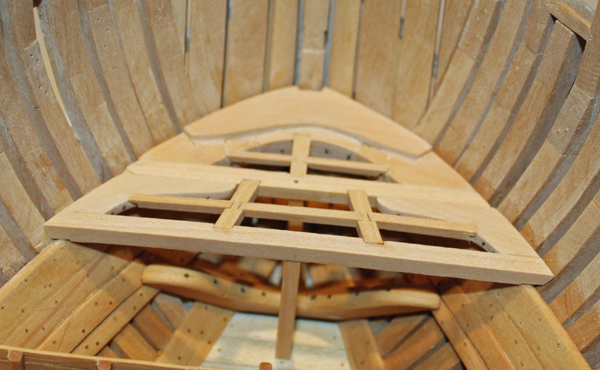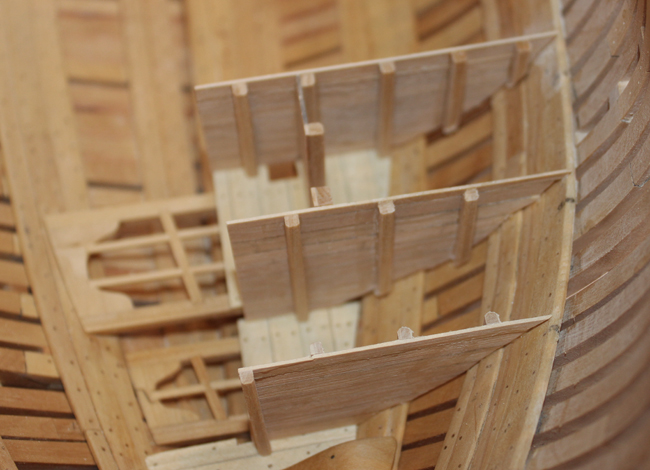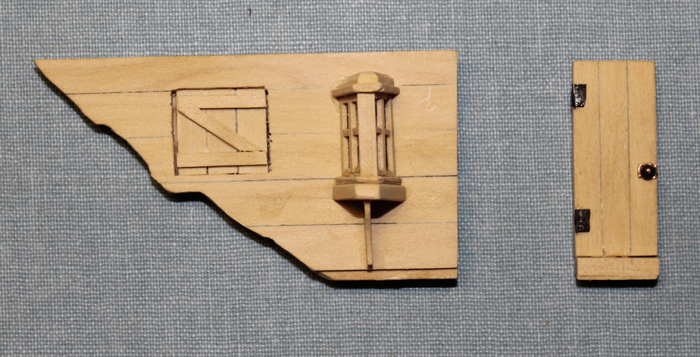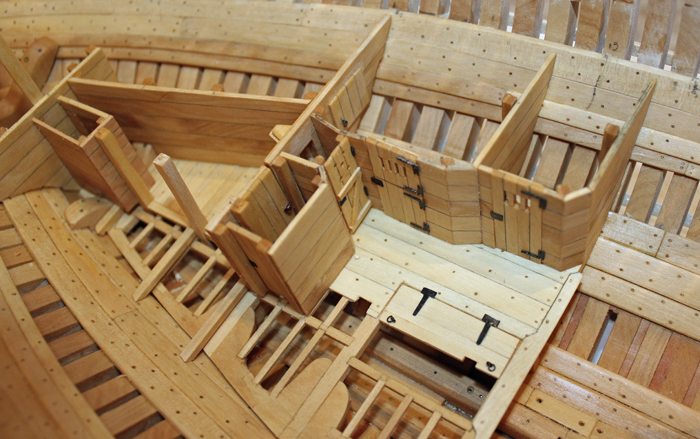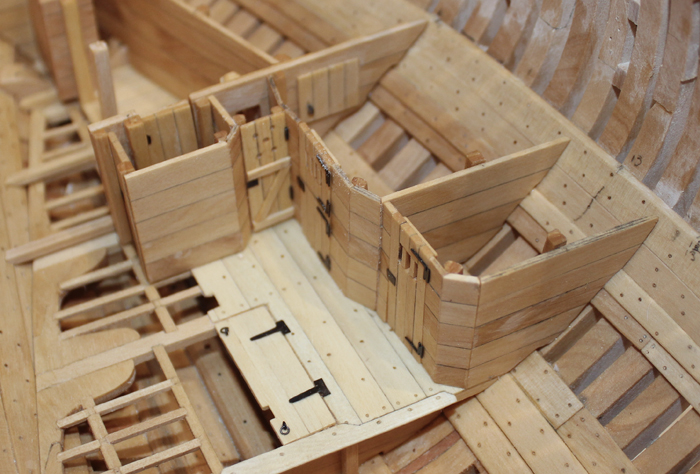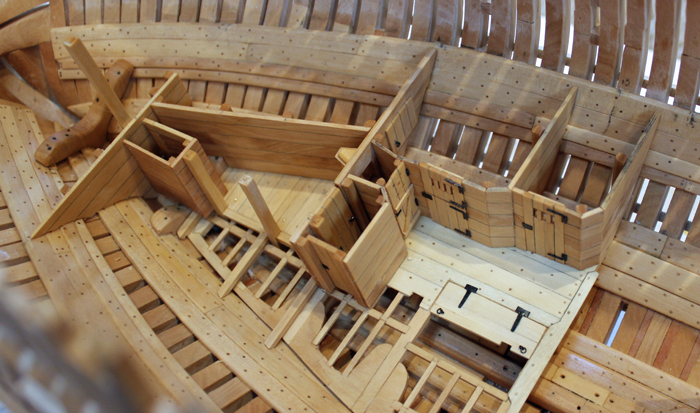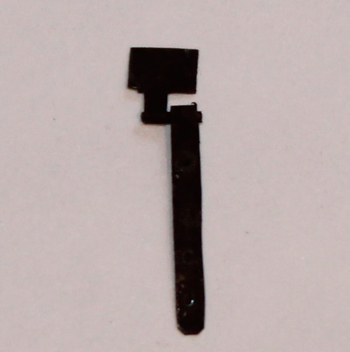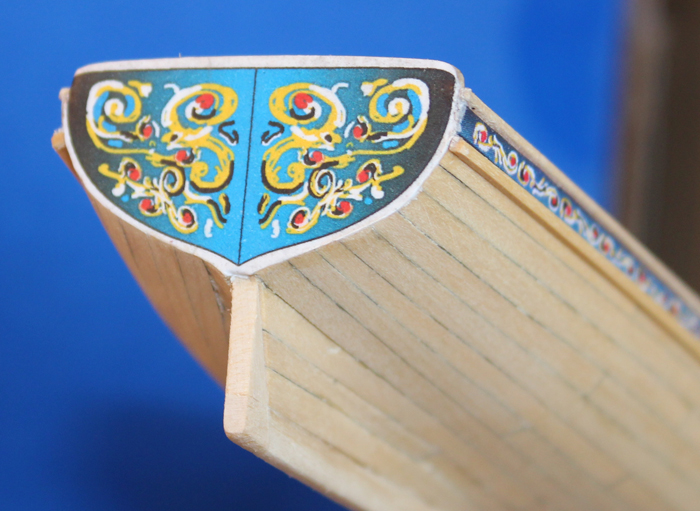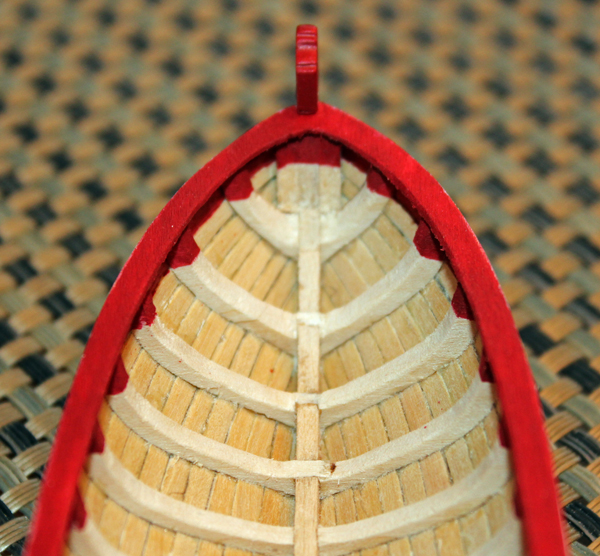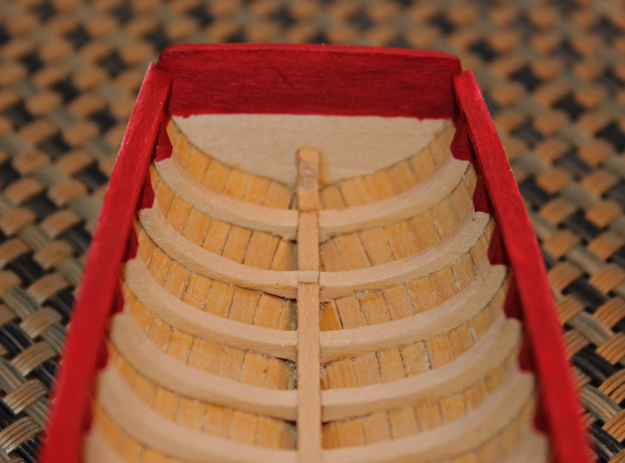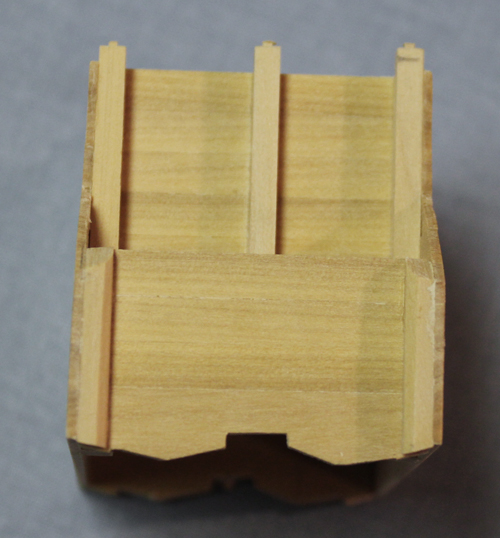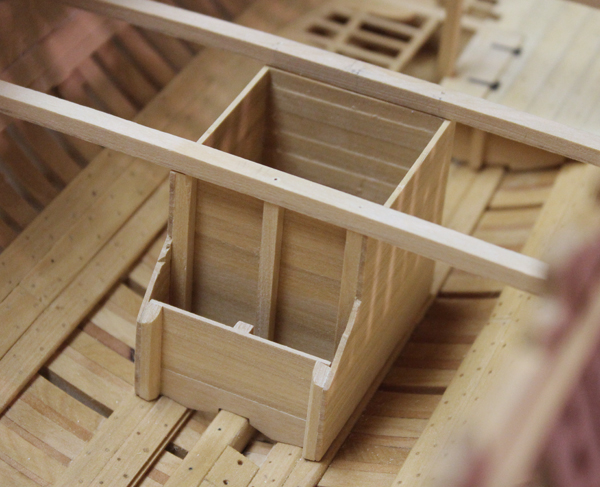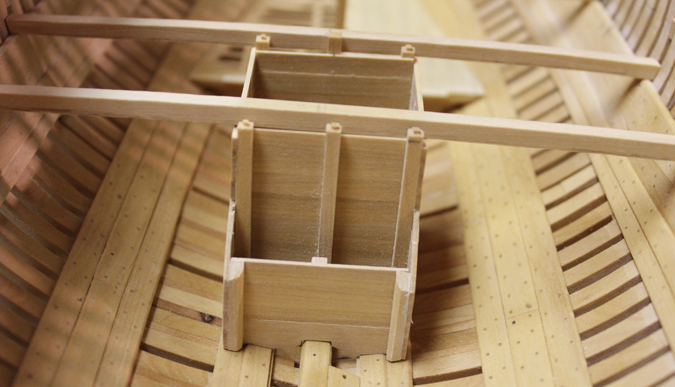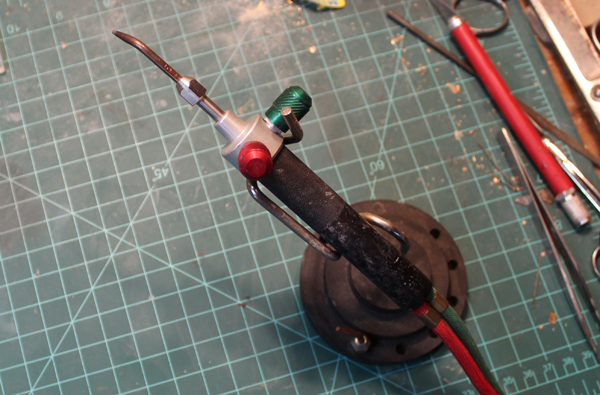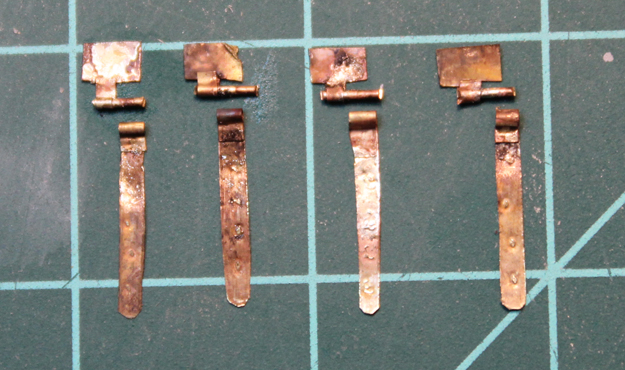-
Posts
2,032 -
Joined
-
Last visited
Content Type
Profiles
Forums
Gallery
Events
Everything posted by tlevine
-
The main mast partner is made the same way as the fore mast partner. There are carlings under the partner which mortise into the underside of beams 11 and 12. In addition to the hole for the mast, two octagonal holes are cut on the aft side of the partner for the pump tubes. There is no hanging knee in this beam set. There are six pump tubes of equal diameter. These were made in similar fashion to making a mast, without the final rounding off of the edges. I first cut a square blank. Next I drew in the required taper and used a chisel to cut the taper. Finally, I put the pump tube in a mast spar jig and turned it into an eight sided tube. Final finishing was done with sandpaper. The photo shows the sequence of forming the pump tubes. I used the photo etch sheet from Admiralty Models to fabricate the pump intake chamber. The spacers are made from brass rod which has been filed down at the ends to form the pins which are protruding from the chamber. The whole assembly was silver soldered and blackened. Here is one of those points where you ask “how much should I install which will never be seen?” I decided to only install the starboard chamber and save the other chamber for (possibly) a cross-section build. Once the lower well is in place and the mast partner installed, it is almost impossible to see the pump chamber.
- 1,449 replies
-
It's great to see another TriClub build posted to MSW!
- 277 replies
-
- model shipways
- 18th century longboat
-
(and 1 more)
Tagged with:
-
Thanks a lot guys. The pictures are going to be a lot slower in coming now as I have almost reached my current point in the build.
- 1,449 replies
-
Danny, I won't tell if you won't tell. Druxey, what is also amazing is that for a ship made of essentially chopsticks and toothpicks it is truly a strong structure.
- 1,449 replies
-
At the dead flat is an interesting knee combination: the opposed lodging knees. This is a combination of two knees: a “normal” lodging knee and what I will call a bent knee because it is obviously bent. This is tricky to make. The knee itself is angled down off the beam so it can duck under the other lodging knee. Then there is an additional buckle in the hull arm so it can stay close to the hull arm of the “normal” lodging knee as it passes below it. There are no ledges mortised in to it for obvious reasons. The beam arms are located between on the fore side of beam 11. These timbers are 7” deep and are mortised into beam 11. Their shape follows the round-up of the beam. I found it easiest to use an 8” timber and give it a final shaping after it had been temporarily secured to the surrounding structures. The main hatch carlings abut the medial end of the beam arms. The outside ledges on either side of the beam arm are wider. There is an iron knee between the fore end of the beam arm and the hull. This lies below the level of the deck. The fore-and-aft arm of the iron knee is hidden underneath the packing piece (a small length of wood between the beam arm and beam 10). I did not have any appropriate brass on hand so I made my “iron” knee from boxwood and painted it black. You can barely see it in the last two pictures.
- 1,449 replies
-
Thanks, Danny. I am finding that, like everything else, it gets a little easier with practice. Those hanging knees are still a pain, though. Greg, I started her in July, 2011. That puts me at least a year behind Danny!
- 1,449 replies
-
These two pictures were originally entitled Starting Over and were taken right after the crash. Beam sets 6 and 7 have been installed. Both of these beams have hanging knees. Starting Over Beam sets 8 and 9 are reasonably simple…no hatches, no hanging knees, etc. What is deceptively hard is continuing a fair run of the carlings along the deck and ledges across the deck.
- 1,449 replies
-
Thank you gentlemen. The dog may look innocent but... We have a saying: "All Sadie; all the time!". As soon as you hit a critical spot, she decides it is play time, squirrel chasing time, food time...you get the idea.
- 1,449 replies
-
Thanks, Chuck. I scribed the edges of the thwarts to match the risers. The top edges were camphered but the bottom edges were left sharp. The thwart at bulkhead B is wider because of the mast. I took the scribing along the edge of the bump-out for the mast. The holes for the belaying pins were marked, scribed and drilled with a #64 bit. I will install them later. The mast bracket and support strips were made with the provided brass strip. I heated the strip in a gas flame to remove any laquer finish and temper the metal for easier bending. Once shaped, they took a bath in isopropanol and a dive into Birchwood Casey. The metal surfaces that would be glued were filed to remove the blackening and then installed with CA (one of the few times I have used it on this model). The thwarts were installed and then a coat of finish was applied. The cockpit seats and trunk lid were made using the provided basswood pieces. Even though the thwarts and risers are boxwood, I decided to use the basswood as this area will be painted. In the pictures they are press fit in place. I have no paint with me this weekend so they will be permanently installed later.
- 75 replies
-
- 18th century longboat
- model shipways
-
(and 1 more)
Tagged with:
-
Tom, Cabrapente, Dave, David and Michael, thanks for looking in. Sadie is very happy that she made an impression. She doesn't look that big next to Hannah.
- 1,449 replies
-
I have the radio on and was reminded that this time last year the temperature was in the low 80's. This year it is unreasonably cold. I was thrilled that it got above freezing for the first time in several weeks. I found a picture of the newly completed hull taken one year ago today and would like to compare it with my progress one year later. The good news is that I have not been distracted with gardening this year. March 2012 March 2013
- 1,449 replies
-
There are hanging knees on the fore side of beam 6. These are a pain to make because of the various thicknesses of the deck clamps and thick stuff. In addition there is the inward curve of the hull to account for. The hanging knee locks into the lodging knee and is bolted to the hull and the fore face of the beam.
- 1,449 replies
-
I guess admin got involved since I only see Bob's post once. Thank you both for your kind comments.
- 1,449 replies
-
I went back and took a picture of the painted stem. Even though I painted over the dark blue/black at the bow, I left the dark color aft. The floor boards were installed next. The central one is wider than the two outer ones. The instructions say to keep the distance between the floor boards the same. I was uncertain whether that meant constant along the length (and as a consequence tapering the floor board towards the bow) or symmetric so I tried both ways. Keeping the floor board a consistent width and gradually decreasing the distance between the boards looked better to me. Once they were installed, I made templates for the fore and aft platforms. The photos show the aft platform stopping at bulkhead 7 but the plans show that it goes aft to the sternpost. I followed the plan. I used pencil on one edge of the planking to highlight the individual boards. The riser strake was installed next. I scribed the top and bottom with an 11 blade using a straight-edge as a guidel It turned out that the correct distance from the rail was exactly where the paint-natural wood transition occurred. Another template was used to get the correct shape for the trunk, located aft of bulkhead 7. Once this was installed I applied a coat of Watco's Danish Wood Oil to the entire hull except for the painted rail. I am still planning on painting the hull below the water line white. I don't think I will have any problem with paint adhesion.
- 75 replies
-
- 18th century longboat
- model shipways
-
(and 1 more)
Tagged with:
-
The foremast partner is an interesting piece of joinery and exemplifies why one should not glue things in place too soon. Although not seen in the pictures, there are two carlings under the plank between the second and third beams. These carlings are mortised under the beams and extend all the way across the beams. The partner is let into the beams by one inch. I made the opening by drawing it out and then drilling multiple holes just inside the outline. Using an Exacto, I connected the dots and cleaned up the octagon with a chisel and sanding sticks. Foremast Partner The lodging knees, carlings and ledges were made and glued-up off the model. I will call a beam and its associated lodging knees, carlings and ledges a beam set for simplicity. Finally the whole eking piece and beams 1-3 assembly was installed with the pillars. Lower Beam 3 Lodging knees Lower Beam 3 Carlings and Ledges Lower Beam 3 Finished The next two beams were installed. Nothing gets glued together in one beam set until the next beam set has been made. As you can see, the angle of the inner carlings of beam set 5 is not symmetric. I mismarked the midline with the obvious result. I did not notice this until it was too late to correct the problem. Since one side of the deck will be planked over, the asymmetry will not be seen unless a fiberoptic scope is passed into the hold. After the trouble I had with beam 2, I have been very careful to make sure the beams are perpendicular to the keel. Beam 5
- 1,449 replies
-
I was very proud of myself until… One of our members (I am sorry that I do not remember which one because you really did me a tremendous service by calling this to my attention) noticed that beam 2 was not perpendicular to the keel. The problem was determined to be the eking piece which was remade and the problem was solved. Happily, I had not glued anything in place on the deck clamp so nothing was damaged in the repair. While building the lower deck structure I have made it a rule not to permanently glue anything in place until I am at least one and preferably two beams down the line in case small adjustments need to be made. The picture on the left shows the problem. The starboard end of the second beam is half a frame width aft compared with the port side. The right hand photo is taken a little later in the build but shows that the beam is now perpendicular to the keel. Remade Eking Piece
- 1,449 replies
-
Here are some more pictures for you Joe. The lower deck hook/eking piece was made next. This is constructed from three pieces of wood hook scarfed together. Another difference from TFFM was found with this piece. The book shows the upper surface of the hook flat whereas the draughts show a rebate at the fore end of the hook. This would allow the deck planking to end on the hook rather than at the footwaling. The pictures show the sequence of construction of the eking piece, beam 1 and their associated carling, ledges and pillar. There is a deliberate gap at the lateral edge of the hook and beam because I am not installing any of the footwaling. Lower Deck Hook The second beam, with its knees, carlings and ledges was installed next. Lower Deck Second Beam
- 1,449 replies
-
The fore platform bulkheads are less complicated than the aft ones. Everything is at a right angle in contrast to the odd corners aft. There is some difference in the door configuration between TFFM and the Atalanta draughts. Greg’s Pegasus also has this configuration (as seen in TFFM vol.3). Fore Platform Bulkheads This picture shows how the well lines up with the aft platform structures. The well will not be glued in place until the lower deck has been partially assembled. The color contrast shows where the finish has been applied.
- 1,449 replies
-
I like your idea of a celebration, Pat. Mark, I am using propane and oxygen for the torch. Although not the most cost effective, I am using the little canisters from the hardware store because of their portability. The finish is Watco's Danish Wood Oil. My can of finish is five years old. I am suspicious that there has been a change in formulation recently, resulting in a shinier finish. Definitely try this product on some scrap before deciding to use it. Thanks for the encouragement, Christian.
- 1,449 replies
-
None of the beams are installed but I have decided to add the finished pillars as the bulkheads are fabricated. This is where I got in to trouble again. The fore bulkhead of the magazine rests on the platform beam and the pillar is fixed to it. Careful (after the fact) review of the plans shows that this pillar is not centered on the lower deck beam. It is shifted aft. The reason for this is that one could not open the passageway doors into the magazine if it was positioned directly under the center of the beam. Openings have been made for the door into the magazine, the light window and the scuttle into the bread room. The mullions for the light room window were made by sawing halfway through the wood strips and then assembling them Lincoln Log style. The glazing is mica. The candle is typing paper rolled around a scrap of wood. The weathered appearance is purely accidental. My fingers were dirty when I made it. Light Room Bulkhead Fore Magazine Bulkhead The remaining rooms on the port side of the platform have been made and installed. Since all of the wood planks for the bulkhead walls are the same dimension, I made up a stock “wall” made up of strips of wood glued together. The lengths of the bulkhead segments were then cut from that stock sheet. Holes are drilled into the upper light room door for ventilation. The hinges on the steward and bread room doors are photo etch from Admiralty Model’s photo etch sheet for Swan Class vessels. This also includes pump assemblies, lanterns and other misc. parts. Aft Platform Bulkheads I have reached the end of the build log rescued by Dave (Midnight). This leaves me about two months to reconstruct de novo. At least I have the pictures...
- 1,449 replies
-
The hinge assemblies were blackened. I have used Blacken It for a long time but I have some Birchwood Casey’s on order for the next batch of metal work. Once they are installed and the finish applied to the wood, I will apply a coat of Floquil reflectance reducer to the hinges. This will even out the color and protect them from getting the gray bloom that plagues blackened fittings (at least mine). I am still deciding on what adhesive to use. I find epoxy too messy. I am considering contact cement. I used it to apply the copper plates on a Cutty Sark twenty years ago and it has shown no signs of failing. Author: druxey. Silver solder and brass soup…been there and done that! On the other hand, I accidentally discovered a new technique. Heat the end of a wire or thin rod. The tip will melt and form a nice ball. Great for metal stanchions! Author: Dan Vad. Epoxy doesn’t have to be messy to use on very small pieces. The trick is NOT to try to clean off any excess until it has at least ¾ set. Then trim it off with a sharp Xacto. Author: remcohe. I used very small drops of thick CA to fix them. Author: druxey. Excess epoxy can also be removed before it is set up by – yes, you’ve guessed it! – isopropanol. I use a Q-tip to do this. Dec. 3, 2012. I did not like the effect from my blackening solution so I took the hinges back to almost bright metal by soaking them in Sparex pickling solution and reblackening them in Birchwood Casey Brass Blackener. Quite an improvement. I installed the hinges using contact cement. I put a tiny stripe of the cement on the door and on the hinge. I let it dry for 15 minutes and then installed them. No adhesive squeezing out. I deliberately made the hinge pins come from the same side. It seemed to me that it might be necessary for someone to remove the lid for access or repair and this would allow the door to be removed more easily. Dec. 3, 2012. There are several rooms built on to the aft and fore platforms. On the aft platform are the magazine and its maze of entry passages, the bread room, the steward’s room, the light room and other rooms on the starboard side of the ship which I will not be installing. Superficially, this seems easy. Build a bunch of walls, trim them to fit, put in a few fenestrations, pop in a few door and voila…instant room. Needless to say, this is not the case. One of the hardest parts of this for me was visualizing how everything went together. I then followed the platform plan, only to discover that the fore and aft positions of the bulkheads were slightly different from the body plan. “Slightly” loosely translates into just enough to make me start over. I decided to start aft and work forward. The aft magazine bulkhead sits behind the mizzen mast step. The aft bulkhead does not go all the way to the hull. There will be a bulkhead connecting the fore and aft magazine bulkheads and lateral to that is storage for the bread room. There is a box surrounding the mizzen mast, keeping it separate from the magazine. The magazine also has a removable false floor, called the palletting. These planks go athwart ship in contrast to the deck flooring. My first mistake was making the magazine area too short. The fore pallet beam had to be remade and a wider plank installed. Compare the 2nd and 4th pictures for before and after shots of the pallet beams and decking.
- 1,449 replies
-
Time again to take a short break from Atalanta (and resurrecting build logs). I used the second to smallest freize downloaded from MSW for the transom. The kit supplied ones were too large. I used very dilute yellow glue to apply the freize and then painted over it with Testor reflectance reducer. The rail, inner bulwarks, etc. were painted with Polly S Soo Line Red paint. The rub rail and edge of the top rail were painted with flat white enamel. The kit instructions suggest using black paint on the stem adjacent to the freize. I had some blue paint (Testors Blue Angel enamel) which matched the color of the freize and used that on the stem. I then feathered the paint onto the freize where the blue darkened to near-black. I will try to remember to take a picture of that and post it next time.
- 75 replies
-
- 18th century longboat
- model shipways
-
(and 1 more)
Tagged with:
-
This is the web site for the torch. A lot of builders in my club use this same torch. http://www.littletorch.com/
- 1,449 replies
-
Thanks, everybody. Sorry for the delay in responding. Between life and the site going down again... Joe, that is a Smith torch. It is used in the jewelry trade. I got mine probably on EBay. It comes available with seven tips of various diameters. I use one of the medium tips. The smallest tips are difficult to stay lit with the gasses I use. I will try to post more of the build log tonight. In real time, I have just finished the holes in the main mast partner for the pumps.
- 1,449 replies
-
I decided to build the lower well/shot locker before the fore and aft platform bulkheads. This would give me more room to work on the well without damaging the bulkheads. The well will be permanently installed later. I build the lateral walls of the well first. Since these planks had cyphered edges, I did not highlight the plank edge with pencil. I then added the stanchions, cutting them long for later fitting with the lower deck beams. The athwartship walls were installed next. The lowest plank is wider and shaped to fit the hull configuration. The next step was to exactly locate the well/locker fore and aft on the keelson. I had previously marked the locations of the lower deck beam stanchions on the keelson and inserted the tenon of the aft wall stanchion into this. I removed the limber boards on either side of the well and will remake them to fit later. Next, I took the lower deck beams and placed them adjacent to the athwartship walls, marking the correct height. The stanchions were cut down, keeping the mortise (for the most part) to insert into the underside of the beam. Now it is time to add the finishing touches. The doors to the shot locker would not have been as air tight as the walls, so these plank edges were highlighted with pencil. I also left a slight gap on either side of the door to highlight the idea that these are two separate doors. Nov. 27, 2012. I made the hinges for the shot locker. I started with shim brass (the second thinnest in a pack containing misc. thicknesses) and heat it in a gas flame to remove any lacquer that might have been applied at the factory. Next, a strap and an offset “T” piece for the hinge were cut. The hinge pin is a brass pin from Model Expo. I put pins in both pieces and formed a loop around the pin. The pin was left in place on the hinge plate and both pieces were silver soldered. I use a Smith Little Torch using propane and oxygen because it gives me a finer flame than a butane torch. With the thin brass this is important because there is a fine line between soldering the joint and creating a brass/silver soup. I attempted to dimple the strap for nail heads and was not very successful so I will simply call it “distressed metal.” With the naked eye you cannot see any detail of the surface of the metal.
- 1,449 replies
About us
Modelshipworld - Advancing Ship Modeling through Research
SSL Secured
Your security is important for us so this Website is SSL-Secured
NRG Mailing Address
Nautical Research Guild
237 South Lincoln Street
Westmont IL, 60559-1917
Model Ship World ® and the MSW logo are Registered Trademarks, and belong to the Nautical Research Guild (United States Patent and Trademark Office: No. 6,929,264 & No. 6,929,274, registered Dec. 20, 2022)
Helpful Links
About the NRG
If you enjoy building ship models that are historically accurate as well as beautiful, then The Nautical Research Guild (NRG) is just right for you.
The Guild is a non-profit educational organization whose mission is to “Advance Ship Modeling Through Research”. We provide support to our members in their efforts to raise the quality of their model ships.
The Nautical Research Guild has published our world-renowned quarterly magazine, The Nautical Research Journal, since 1955. The pages of the Journal are full of articles by accomplished ship modelers who show you how they create those exquisite details on their models, and by maritime historians who show you the correct details to build. The Journal is available in both print and digital editions. Go to the NRG web site (www.thenrg.org) to download a complimentary digital copy of the Journal. The NRG also publishes plan sets, books and compilations of back issues of the Journal and the former Ships in Scale and Model Ship Builder magazines.


